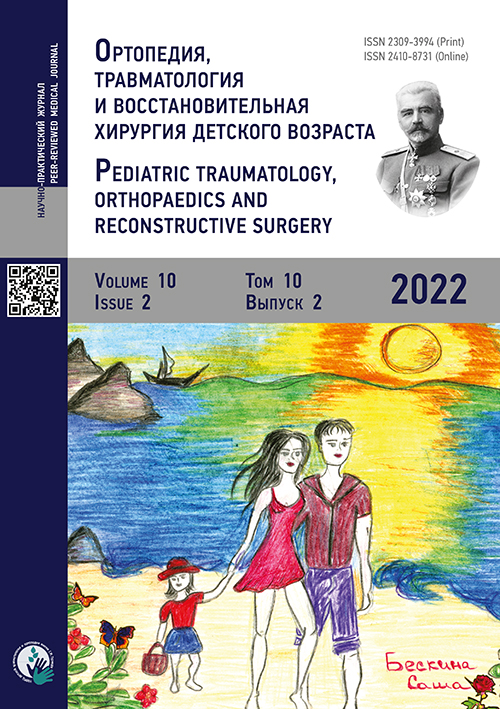Analysis of X-ray parameters of the acetabulum in patients with cerebral palsy
- Authors: Novikov V.A.1, Vissarionov S.V.1, Umnov V.V.1, Zharkov D.S.1, Umnov D.V.1
-
Affiliations:
- H. Turner National Medical Research Center for Сhildren’s Orthopedics and Trauma Surgery
- Issue: Vol 10, No 2 (2022)
- Pages: 143-150
- Section: Clinical studies
- Submitted: 11.01.2022
- Accepted: 17.05.2022
- Published: 30.06.2022
- URL: https://journals.eco-vector.com/turner/article/view/96210
- DOI: https://doi.org/10.17816/PTORS96210
- ID: 96210
Cite item
Abstract
BACKGROUND: Among the orthopedic consequences of cerebral palsy, instability of the hip joints is one of the most common. Most children with cerebral palsy at birth have close to normal relationships in their hip joints that gradually deteriorates. Progressive instability of the hip joint leads to subluxation and then dislocation of the hip, to a decrease in the range of motion in the joints, to movement disorders and a defect in the ability to sit, as well as an impairment in hygienic care of the child.
AIM: To analyze the X-ray anatomical structure of the acetabulum in unstable hip joint in children with cerebral palsy.
MATERIALS AND METHODS: We examined 42 hip joints in 23 patients with cerebral palsy. Participants were divided into two groups. The main group included the results of the examination of unstable hip joints (31 studies), and the control group included the results of the examination of stable joints (11 studies).
RESULTS: The average index of anteversion of the acetabulum in the main group with a functioning Y-shaped cartilage was 2.5° more than the average value of the norm (p = 0.029), with a nonfunctioning Y-shaped cartilage at 6° less than the normal value (p = 0.017). There was a positive moderate correlation between the anteversion of the acetabulum and the anterior margin angle (r = 0.424, p = 0.017), and a positive moderate correlation between the acetabular index and the anterior margin angle (r = 0.398, p = 0.027).
CONCLUSIONS: The study showed that changes in the acetabulum in patients with pathological dislocation or subluxation of the hip against the background of spastic cerebral palsy were manifested by deformation in the horizontal plane due to retroversion of the acetabulum.
Full Text
About the authors
Vladimir A. Novikov
H. Turner National Medical Research Center for Сhildren’s Orthopedics and Trauma Surgery
Email: novikov.turner@gmail.com
ORCID iD: 0000-0002-3754-4090
Scopus Author ID: 57193252858
MD, PhD, Cand. Sci. (Med.)
Russian Federation, 64-68 Parkovaya str., Pushkin, Saint Petersburg, 196603Sergei V. Vissarionov
H. Turner National Medical Research Center for Сhildren’s Orthopedics and Trauma Surgery
Email: vissarionovs@gmail.com
ORCID iD: 0000-0003-4235-5048
SPIN-code: 7125-4930
Scopus Author ID: 6504128319
ResearcherId: P-8596-2015
MD, PhD, Dr. Sci. (Med.), Professor, Corresponding Member of RAS
Russian Federation, 64-68 Parkovaya str., Pushkin, Saint Petersburg, 196603Valery V. Umnov
H. Turner National Medical Research Center for Сhildren’s Orthopedics and Trauma Surgery
Email: umnovvv@gmail.com
ORCID iD: 0000-0002-5721-8575
MD, PhD, Dr. Sci. (Med.)
Russian Federation, 64-68 Parkovaya str., Pushkin, Saint Petersburg, 196603Dmitry S. Zharkov
H. Turner National Medical Research Center for Сhildren’s Orthopedics and Trauma Surgery
Email: striker5621@gmail.com
ORCID iD: 0000-0002-8027-1593
MD
Russian Federation, 64-68 Parkovaya str., Pushkin, Saint Petersburg, 196603Dmitry V. Umnov
H. Turner National Medical Research Center for Сhildren’s Orthopedics and Trauma Surgery
Author for correspondence.
Email: dmitry.umnov@gmail.com
ORCID iD: 0000-0003-4293-1607
MD, PhD, Cand. Sci. (Med.)
Russian Federation, 64-68 Parkovaya str., Pushkin, Saint Petersburg, 196603References
- Miller F. Cerebral palsy. N.Y.: Springer; 2005. P. 387−432.
- Valencia FG. Management of hip deformities in cerebral palsy. Orthop Clin North Am. 2010;41(4):549−559. DOI: 10.1016/j. ocl.2010.07.002
- Flynn JM, Miller F. Management of hip disorders in patients with cerebral palsy. J Am Acad Orthop Surg. 2002;10:198–209. doi: 10.5435/00124635-200205000-00006
- Scrutton D, Baird G, Smeeton N. Hip dysplasia in bilateral cerebral palsy: incidence and natural history in children aged 18 months to 5 years. Dev Med Child Neurol. 2001;43:586–600. doi: 10.1017/s0012162201001086
- Hagglund G, Alriksson-Schmidt A, Lauge-Pedersen H, et al. Prevention of dislocation of the hip in children with cerebral palsy: 20-year results of a population-based prevention programme. Bone Joint J. 2014;96-B:1546–1552. doi: 10.1302/0301-620X.96B11.34385
- Terjesen T. The natural history of hip development in cerebral palsy. Dev Med Child Neurol. 2012;54:951–957. doi: 10.1111/j.1469-8749.2012.04385.x
- Huser A, Michelle M, Hosseinzadeh P. Hip surveillance in children with cerebral palsy. Orthop Clin North Am. 2018;49(2):181−190. doi: 10.1016/j.ocl.2017.11.006
- Shore B, Spence D, Graham H. The role for hip surveillance in children with cerebral palsy. Curr Rev Musculoskelet Med. 2012;5:126–134. doi: 10.1007/s12178-012-9120-4
- Kim HT, Wenger DR. Location of acetabular deficiency and associated hip dislocation in neuromuscular hip dysplasia: three-dimensional computed tomographic analysis. J Pediatr Orthop. 1997;17:143–151.
- Hingsammer AM, Bixby S, Zurakowski D, et al. How do acetabular version and femoral head coverage change with skeletal maturity? Clin Orthop Relat Res. 2015;473(4):1224−1233. doi: 10.1007/s11999-014-4014
- Sadof’yeva VI. Rentgenofunktsional’naya diagnostika zabolevaniy oporno-dvigatel’nogo apparata u detey. Leningrad: Meditsina; 1986. (In Russ.)
- Heidt C, Hollander K, Wawrzuta J, et al. The radiological assessment of pelvic obliquity in cerebral palsy and the impact on hip development. Bone Joint J. 2015;97-B:1435–1440. doi: 10.1302/0301-620X.97B10.35390
- Jóźwiak M, Rychlik M, Szymczak W, et al. Acetabular shape and orientation of the spastic hip in children with cerebral palsy. Dev Med Child Neurol. 2021;63(5):608−613. doi: 10.1111/dmcn.14793
- Chung CY, Park MS, Choi IH, et al. Morphometric analysis of acetabular dysplasia in cerebral palsy. J Bone Joint Surg [Br]. 2006;88-B:243−247. doi: 10.1302/0301-620X.88B2.16274
- Chang CH, Ken N, Chao JW, et al. Acetabular deficiency in spastic hip subluxation. J Pediatr Orthop. 2011;31(6):648−654. doi: 10.1097/BPO.0b013e318228903d
- Kim HT, Wenger DR. Location of acetabular deficiency and associated hip dislocation in neuromuscular hip dysplasia: three-dimensional computed tomographic analysis. J Pediatr Orthop. 1997;17:143–151. doi: 10.1097/00004694-199703000-00002
Supplementary files















